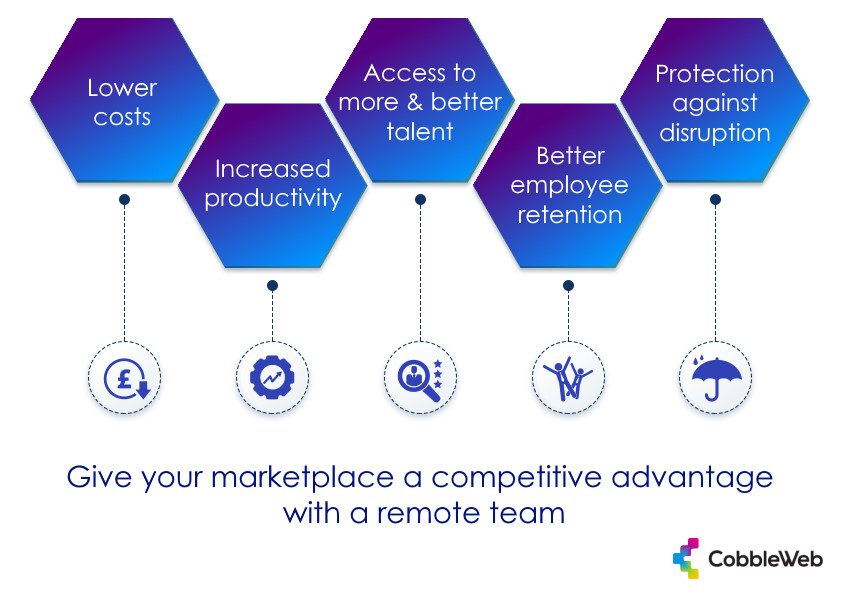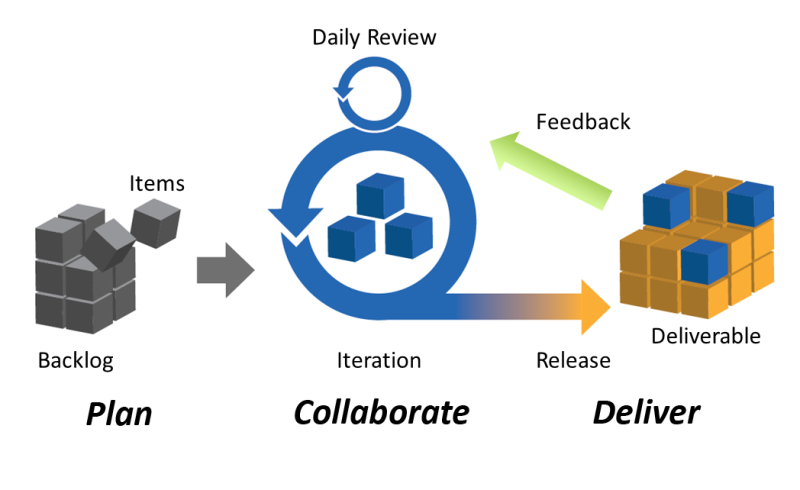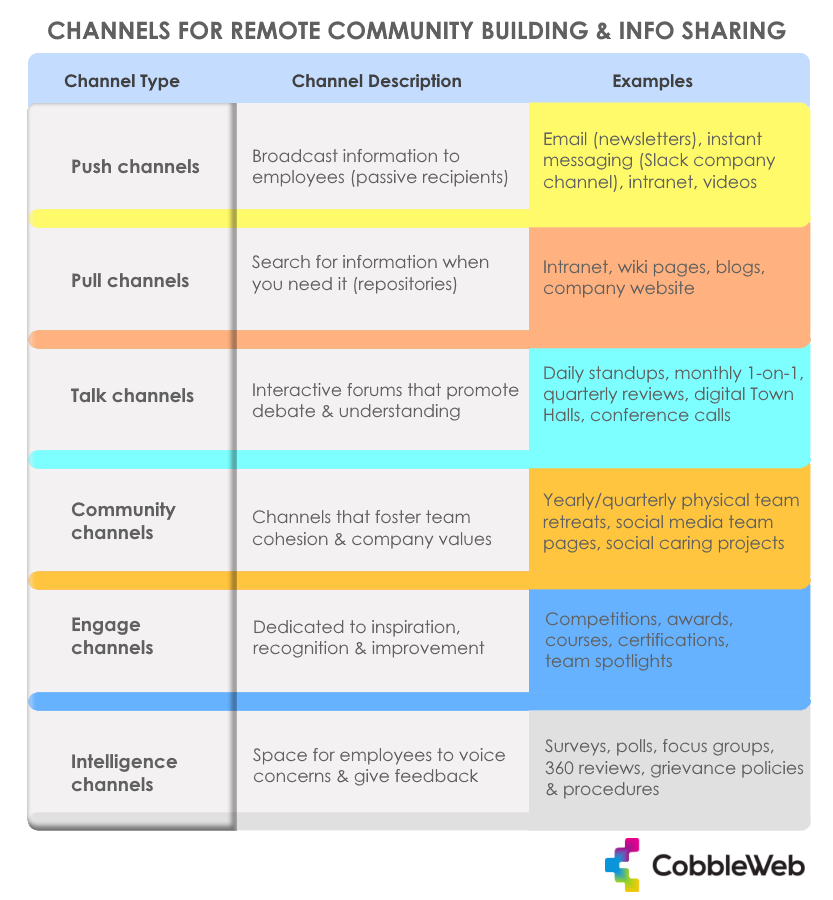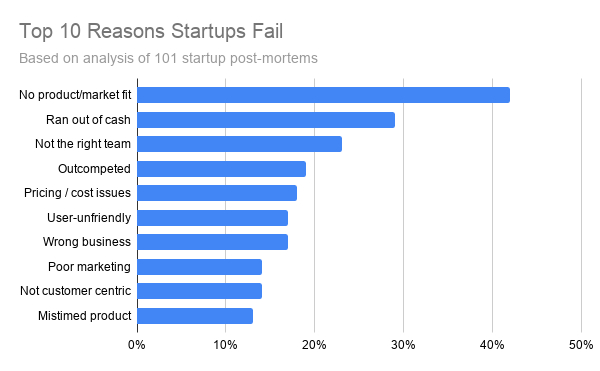Headlines across the world have been pretty emphatic: the coronavirus epidemic has brought business as we’ve known it to a standstill. Millions have lost their jobs and even more have had to adjust to working from home. Chances are therefore good that you have recently come across more than one article singing the praises of remote work or explaining how to run a distributed organisation. This is of course not news for digital startups such as online marketplaces. The coronavirus is just one more good reason why savvy marketplace entrepreneurs are building their platforms with distributed teams.
‘This isn’t just a pause – it’s an entire reset of our economic system’
Johann Rupert, chairman of Swiss luxury goods company, Richemont.
“It seems extremely implausible to us that life will return to the status-quo-ante, which is the underlying presumption of virtually all the forecasts right now.”
Wolfgang Munchau, associate editor for the Financial Times.
Some pundits may be hoping for business as usual in future, but the fact is things will never be the same again. Remote work is here to stay and will surge in momentum as more businesses cross the digital divide. Business development and management models will be forced to change. Agile, digital-first companies with flat hierarchies will thrive, while traditional top-down monoliths will come under increasing pressure.

Continue reading to learn more about the advantages and challenges of developing your online marketplace with a distributed organisation. We’ve also added a practical guide for running remote teams, based on many years of experience.
What does ‘distributed organisation’ mean?
In a modern distributed company, geographically dispersed employees work on related tasks and projects towards a common goal, using technology to communicate and collaborate in real time.
The key characteristics of a distributed organisation are therefore:
- Physically remote workers
- Team members operate as an interconnected network
- Connections are facilitated by technology such as SaaS
The rise of distributed organisations
Although remote work is not new, the world has come a long way from communicating via telegraph, telex, or fax. Never-ending email threads and clunky analogue teleconferences have been superseded by the rapid growth in SaaS applications like Slack instant messaging and Zoom video conferencing. This digital revolution has greatly reduced the need for colocation, with collaborative cloud software now available for almost every business function.
400% growth in remote work since 2010
– Research by business software discovery platform, GetApp: Findings from a decade in tech
16% of global companies were fully remote in 2018
– Research by video conferencing tech company, Owl Labs: Global State of Remote Work
74% increase in UK remote workers between 2008 and 2018
– Research by Office for National Statistics: Labour Force Survey
Digital companies, especially startups, have been at the forefront of the move to a distributed model. Half of e-commerce platform Shopify’s 5,000 employees work remotely. Software development platform, GitHub, operates with a more than 60% remote workforce.
Upwork, the global freelance platform, is a poster child for marketplaces that make extensive use of distributed teams. Even its co-founder, Stratis Karamanlakis, works from his Athens home, instead of the company’s Santa Clara, California headquarters.
Successful fully-distributed digital companies include well-known names like Basecamp, Mozilla, Automattic, Kissmetrics, Buffer, Zapier and MySQL.
Tech companies that do not embrace remote work may do so at their peril. Remember when Marissa Mayer, ex-CEO of Yahoo, banned remote work? Commentators have said that loss of talent was one of the reasons why the company went from a $100bn valuation in 2000 to selling its core business for a ‘paltry’ $4.83bn in 2016.
However, a remote-work ethos does not necessarily guarantee success. WeWork, the shared workspace platform and champion for distributed teams, experienced a cataclysmic fall from grace in 2019, plummeting from a $47 billion valuation to below $5 billion in less than a year. The consensus was that an irresponsible corporate culture and alleged CEO malfeasance were to blame.
WeWork’s collapse offers a cautionary tale. Paying lip-service to innovative organizational models is no substitute for transparency, structure, and accountability. Marketplace entrepreneurs should carefully weigh up the pros and cons of building their platform with a dispersed team. They also need to fully understand the prerequisites for a successful distributed organization.
6 reasons why you should build your online marketplace with a distributed team
It’s cost-effective
Employers can save on office rentals, office equipment, utilities, and other overheads, while employees pay less for fuel, car maintenance and parking fees. Employees also save on rent as they don’t have to move to expensive cities like London or New York. This is in line with the Lean approach which focuses on maximising customer value while minimising costs.
It’s good for productivity
It has been known for a while that well-managed distributed teams have the ability to outperform colocated teams. Harvard Business Review reported back in 2014 that employee productivity can shoot up with more than 40% under the right circumstances.
According to research by video conferencing manufacturer, Owl Labs, better focus and productivity is the number one reason why people prefer to work remotely.
And what better authority than Google, which has 100,000 employees spread across the globe. They studied 5,000 of them over two years and found that those working remotely had the same productivity as their office-bound colleagues. Minus the long commutes and high overheads of course.
A wider and deeper talent pool
A distributed approach gives your business access to more potential employees across the world. Not only that, it also improves the chances of recruiting top talent that are not available locally or are out of your budget. With sky-high salaries dominating labour markets in tech hubs like Silicon Valley and London, even established platforms are looking at remote teams as a solution.
Our concentration in San Francisco is not serving us any longer, and we will strive to be a far more distributed workforce, which we will use to improve our execution,
– Jack Dorsey, CEO of Twitter and Square.
Access to a larger talent pool also promotes diversity, which has been touted as an important driver of innovation by respected institutions such as the World Economic Forum and Harvard.
“More diverse companies, we believe, are better able to win top talent and improve their customer orientation, employee satisfaction, and decision making, and all that leads to a virtuous cycle of increasing returns.”
– According to management consultants, McKinsey
Better employee retention
Remote teams that operate within a well-structured environment tend to exhibit better time management. Together with a lack of long commutes and time-wasting office banter this can substantially improve employee work-life balance.
Happy employees are loyal team members. No surprise then that US companies that allow remote work have reported a 25% reduction in staff turnover. Since it is accepted wisdom that it is much cheaper to retain employees, than to recruit and train new ones, this can have a huge impact on your marketplace startup’s financial resources.
Greater protection against unforeseen disruption
As the coronavirus pandemic has shown, a black swan event or other form of sudden disruption can cause havoc to businesses. Distributed organisations tend to be less vulnerable to certain types of adversity such as labour or geographical shocks. Amazon’s sales surge during the current health crisis is a good example.
Competitive advantage
Getting your distributed organisation right will also mean that you have created a competitive advantage over your competitors. Better talent, lower costs and higher productivity could be the edge that your marketplace needs to stand out.
Getting it right also means that you should be able to scale your organisation quicker. Once the structure and processes have been set up and tested, new sub-units can be replicated at pace.

Roadblocks to building an effective distributed team
It’s easy to get excited about all the advantages of building your marketplace with a remote team. Successfully pulling it off though, may not be that easy, with multiple challenges awaiting the novice founder.
Lack of a common culture
First up is the challenge of building a common culture. It can be tough to sell your startup’s vision and values when none of your team share a physical space. Without a well-defined shared culture it’s hard to determine if candidates will be a good fit for your company. It is also difficult to retain people when they don’t feel like they belong to something bigger than themselves.
Inadequate communication skills
This is a biggie. Without the right linguistic capabilities, the quality of communication in your business and thus the results will suffer.
All team members need to be able to communicate at a satisfactory level, both verbally and in writing. Inadequate language skills can lead to misunderstandings or mistakes and undermine your team’s cohesion.
Additionally, not knowing when and how to use specific communication channels (instant messaging, comment features, email, video or audio calls) can cause confusion and frustration.
Tightly coupled work, where team members are very dependent on each other’s input, presents a very specific challenge. Since tightly coupled work requires high levels of collaborative efficiency, the quality of communication is of the utmost importance.
Inadequate technological infrastructure
Slow internet speeds and lack of hardware capacity can kill your business before it’s out of the gate. Your team needs sufficient bandwidth and computer power for clear communication channels (audio, video) while running multiple SaaS applications at the same time. There’s nothing like frozen apps and videos, or audio that keeps cutting out, to pour cold water on team collaboration, product development, sales and customer service.
Missing technological insights
If you have never run a distributed organisation before, it can take a while to figure out which communication and collaboration tools are best for your business and how to use them. For example, not using version control software properly will probably cause a few cataclysmic disasters. Some communication tools, like Slack, can negatively impact productivity, especially if they are implemented willy-nilly without guidelines.
Weak remote management skills
Managing team members who are situated across multiple time zones is a tricky job. Poor time management and haphazard scheduling will hamper your team’s efficiency, while inconsistent information-sharing and ineffectual communication will reduce focus and productivity.
Normal leadership best practices still apply. Applying them in a remote environment can be challenging though. Many remote managers, for example, struggle to build a level of cohesion that motivates the team to work smoothly together towards a common goal.
The (in)human factor
Feelings of isolation and lack of human connections can wreak havoc on your remote team’s motivation. Many remote workers complain that they are treated like disposable units or robots instead of valued team members. Finding creative ways to ensure your team is close-knit and motivated can be challenging.
Lack of accountability
With no-one leaning over their shoulders, it can be hard to hold remote employees, especially those who fail to deliver to expectations, accountable. Using time trackers and monitoring tools can be seen as invasive and demoralising, which means you have to rely on remote employees to work independently and conscientiously.
Take some pressure off your business. Partner with marketplace development experts who will slot in seamlessly with your remote team. Learn more
How to build your marketplace platform with a distributed organisation
After you have weighed up the pros and cons and decided to go with a distributed model, you will need a best practices framework to put it in place. With that in mind, we’ve put together some tried and tested tips you can use as a guide to set up and manage a remote team for your online marketplace.
Recruit the right people
According Harvard Business Review (HBR), the ideal character traits for a remote team member includes,
“. . . good communication skills, high emotional intelligence, an ability to work independently, and the resilience to recover from the snafus that inevitably arise. Awareness of and sensitivity to other cultures . . .”
You would also want them to be self-motivated, fast learners who are good at task prioritisation and time management. HBR recommends using behavioural tools like the Myers-Briggs personality test to screen candidates for the right qualities.
Structure your recruitment needs by clearly outlining the required competencies for each role in terms of knowledge, skills and abilities*. By assigning a weight to each competency (taking into account the requirements of a remote role) your recruiters will be better able to compile a shortlist of candidates.
[*Knowledge refers to a person’s understanding of a task, while skills are the learned and practiced proficiency they apply to a task. Abilities indicate the natural capacity or potential of a person to perform those tasks. Together they form the competencies for the range of tasks required by a specific role.]
Vetting competencies by looking at CVs and portfolios is not enough; give candidates a practical test to see how they fare with scenarios applicable to your distributed business.
Hire people according to the work they do, not to the beautiful stories they can tell in their resumes.
– Jason Fried and David Heinemeier Hansson, the founders of Basecamp and authors of Remote: Office Not Required
A probationary period of up to three months is essential for remote jobs. It gives both the new employee and the employer a chance to see if they are a good fit for each other. Make sure that the terms of the probationary contract are clear and that your onboarding process is super effective. If you have the resources, a buddy system for new recruits may also be a good idea.
Hone and adapt your leadership skills
Those without experience of looking after distributed teams, may find the learning curve a bit steep, but at the end of the day, it boils down to applying some basic principles. Your leadership should:
- build trust
- provide direction within a clear structure
- create ownership
- exert the right amount of oversight
Displaying empathy goes a long way towards building trust and buy-in. A too rigid approach can make employees feel like robots or disposable units, which is of course not ideal for job loyalty. Where possible, you should allow flexible work hours, as long as it does not interfere with team collaboration. Make sure everyone takes enough leave to maintain a happy work-life balance.
Show that you care with occasional video or audio check-ins that cover not only the business, but also how it fits in with their lives. Displaying an interest in what remote employees care about will give you better insight into their level of commitment and job satisfaction. Sometimes a more casual conversation can even reveal a skill or insight that you were not aware of.
Transparent communication and open dialogue are important ingredients for building trust and providing direction. Set clear goals and expectations; then make sure everyone understands and buys into them.
Promote the company’s vision and values on a regular basis via internal newsletters, IM updates, and video conferences. Also share updates about significant milestones and celebrate individual or team achievements. After all, you should be your business and your people’s number one cheerleader.
Always welcome suggestions and inculcate a culture of robust but respectful interaction. Since you employed your team members based on their expertise, you should be listening to them too!
Remote leaders need to be adept at driving accountability without micromanaging. Staff monitoring and tracking tools can be perceived as invasive and distrustful. Rather take a leaf out of software development’s Agile handbook and implement sprint cycles with agreed upon time allocation for each task. Sprint planning and reviewing at the beginning and end of each cycle contributes to ownership of tasks and projects.

Monthly one-on-one meetings and quarterly reviews should be used to track performance, exchange feedback, and implement corrective measures if required. For that you are going to need a productive framework like Objectives and Key Results (OKRs) which relies on specific measurable actions to achieve clearly defined goals. OKRs can be expanded from individual to team and even company level.
Formal documents can provide structure and a sense of security for your people. A code of conduct, company values, mission statement and a list of minimum expectations should be drawn up and presented to new team members when you on-board them. Make sure it contains procedures for grievances and the disciplinary process.
Build a strong collaboration & communication framework
The quality of your distributed team’s communication and collaboration hinges on three aspects: skills, structure, and technology. Communication skills have been addressed in the recruitment section above, so we’ll focus on the other two here.

The structure
First of all, it’s important to promote collaboration, not compromise. Your goal should be to merge the different skills and perspectives of all team members in a productive manner. Creating minimum standards for communication can drive that goal.
Make sure your team knows when and how to use different communication channels. Use instant messaging for brief conversations, email for detailed fact-filled exchanges, and voice calls when urgent feedback or lots of discussion is required. Instill proper communication etiquette; for instance, don’t mix physical and virtual teams. As with all tasks, your communication culture should emphasise follow up and follow through. If someone does not respond to an email, phone or message them!
Software development’s agile methodology offers another great tip. Short daily standup meetings are great for making sure everyone is on the same page and checking if anyone is struggling with a task. Collaboration software like Jira offers remote teams a digital equivalent with team members summarising what they have accomplished the day before, what they are working on that day, and whether they have encountered any roadblocks.
The technology
Who remembers the cumbersome old technology of the 1980s? Physical answering machines that ran out of tape, fax machines that ran out of toner and paper, and simplistic pagers seem so archaic and cumbersome these days. Ironically all the advances in hardware and software have created a new problem: too many options make it difficult to choose the right ones. Here’s list a of tried and tested technology to simplify the process:
Hardware
Get your team to run a virtual desktop from their own devices with Amazon Workspaces. It eliminates issues with hardware and operating system compatibility. Workspaces also expedites the onboarding process and makes it super easy to add or remove software applications to your team’s virtual desktops. In addition, software applications are always up to date and all data is securely encrypted in the AWS cloud, with none stored on the local device.
You can take your team’s hardware performance one step further by shipping them each a cheap Thin Client that is optimised for Amazon Workspaces. It may also promote better separation between private and professional lives since it contains less distractions.
Software
- Video conferencing: Zoom is all the rage, but there’s also a strong case for Google Hangouts Meet. Skype is still widely used and GoToMeeting has a loyal following.
- Project management: Jira, Trello, Asana, Airtable
- Collaboration/Team workspace: Basecamp, Confluence
- Instant messaging: Slack, Microsoft Teams, Google Hangouts Chat
- Screencasting (aka screen capture): Loom videos are great ways to explain what words can’t.
- Virtual whiteboards (for brainstorming or mapping product development, a process sequence, or campaign): Miro, Realtime Board
- Design collaboration: InVision, Sketch, Figma
- Software development (collaboration, version control, repositories and code reviews): GitHub, GitLab, Bitbucket
- File management (creating, collaborating, storing, sharing): Google Drive, OneDrive
- HR (payroll, onboarding, leave tracking, performance management) : BambooHR , Gusto, Rippling
- Recruitment (applicant screening, candidate pipeline management, job board integration, interview scheduling): Recruitee, BambooHR
- Password manager: LastPass, OneLogin
- Workflow automation (connects apps, expedites software integration): Zapier
Build a productive & motivated culture
The more energy and thought you put into processes, habits and behaviours that make work easier and more enjoyable, the more motivated and productive your people will be. Achieving this within a distributed organisation requires some creativity and smart use of technology.
Foundations for a productive environment
In the absence of physical oversight, clearly structured processes are key to productive remote work. All tasks should have someone assigned to them, have due dates, and show a status (e.g. in progress, in review, finalised).
Most collaboration tools allow you to add observers to tasks, who will be notified when the task is created, changed or completed. A task comment feature can help discussions take place within the right context, makes general chat less cluttered, and leaves an easily accessible record.
Make sure goals and expectations are clear and bought into at every level via quarterly action plans, monthly one-on-ones, sprint planning and sprint reviews. Keep those goals front of mind with regular mentions and track progress with OKRs (set up an auto update with a goal-setting tool like Weekdone). Avoid robotic processing of tasks by focusing on the quality of outcomes.
Roles and responsibilities should be clearly defined to provide direction and prevent overlap. See this section for guidelines about the remote roles you will need to develop and grow your online marketplace.
Establish common ground through shared knowledge. Repositories on an intranet, wiki pages and blogs can help new team members get up and running quicker. These channels can also serve as a minimum standards reference point for the whole team.
Don’t try to do everything; it makes sense to outsource non-core competencies to specialists. Learning how to code (even when using a marketplace template or web builder), while simultaneously trying to build a distributed business, is a recipe for disaster.
Inspire, Nurture and Motivate
Sell your marketplace vision often and well. It provides an important sense of purpose and inspiration for people who do not share an office. Use every available opportunity and channel for community building and information sharing.

Online competitions and challenges promote friendly rivalry and help your team to get to know each other. Balance out the fun and games with plenty of acknowledgement in the shape of awards (e.g. problem solver of the month) and incentives. Acknowledgement can also take the form of extra responsibilities, such as giving a virtual presentation to the team. Create community channels for the aforementioned on Slack or social media.
Support personal and professional development by giving paid time off for courses and certifications that are relevant to the different team roles. Your employees’ sense of achievement will translate into better retention and higher skill levels for your business.
Get feedback, lots of it. Polls, surveys, 360 degree reviews can all help to find out where your team’s weaknesses and strengths lie.
Some remote-first teams, like Zapier and Buffer, organise quarterly or yearly meetups to foster more personal relationships within their workforce. Occasionally, meeting face to face can help to humanise and contextualise people, which in turn can boost remote communication and teamwork.
A proviso would be that the meetups are organised around constructive interaction without being too prescriptive. Alternating conference-style presentations with fun activities and excursions should do the trick.
A less expensive digital, but still personalising, option would be to share video tours of team members’ work spaces. Just make sure they’re neat and clean.
Which remote roles do you need to build your marketplace?

Getting your team right is crucial, both as a startup and as a distributed company. During the early stages of your marketplace some functions can be fulfilled by the same team. For instance, sales and customer success can be combined initially. The scope of your remote teams will depend on your platform’s requirements and your financial resources. Here is a brief summary of some of the most important roles.
Marketing
Your marketing team should focus on creating brand awareness, driving demand side traffic (buyers), and generating supply side leads (sellers) via on-page SEO, advertising channels, and other forms of content marketing.
Recruiting one or two full-time marketing specialists with some knowledge of your market and product will give you the most bang for your buck. Look out for candidates with business development and leadership skills and experience; they can help you scale this team.
Sales
The sales team is responsible for merchant generation (seller signups), lead qualification and conversion (paid users), looking after new merchants, assisting with user onboarding, eliciting and analysing user feedback, audience segmentation, and customer success.
Remote sales teams can be run full-time in-house, outsourced to an external company, or made up of part-time freelancers. Remember to compare scalability with cost and effectiveness.
Product
This team looks after product vision and strategy, outlines the product roadmap, analyses the competitive landscape, identifies new features and schedules updates. In an early-stage startup this is usually a collaborative effort between the founders and the development and sales teams. Once the marketplace has achieved product/market fit it is probably a good idea to employ dedicated product managers.
FinOps
You will need a finance and operations team to take care of human resource aspects such as recruitment and payroll, company logistics, financial modelling, internal audits and day-to-day accounting. Ideally this team should be headed by a qualified accountant, in conjunction with one of the founders, and make use of a team acquisition specialist.
Development / software engineering
Developers form the engine of your remote team, without them there is nothing to market or sell. This team is responsible for designing the system architecture, building the platform, delivery of new features, optimising and maintaining platform performance, and sorting out bugs and site incidents. UX/UI design can form part of the development team or stand on its own, depending on resources and available skill sets.
In general there are three options: DIY with an off-the-shelf marketplace template, using freelance platforms like Toptal and YouTeam, or contracting with a development partner that specialises in custom marketplaces. A potential fourth option, building an in-house development team, is beyond the budget and expertise of most early-stage marketplace startups.
Using a DIY marketplace builder may seem cheaper and quicker initially, but there are some serious drawbacks, especially if the founders have no software development expertise.
Building a remote development team with freelancers can also be problematic. Startup gurus like Michael Seibel, CEO of Y Combinator, are not fans. In their opinion, freelancers lack commitment and don’t really care about your business success. And then there’s the question of who will manage them if the founders have no software development experience?
In contrast, an experienced development partner with its own distributed team offers several advantages. They can keep costs down compared to a colocated company, have the expertise to get up and running quickly, can offer valuable advice, and can scale to suit your needs. All of which means a better quality product with better chances of success.

